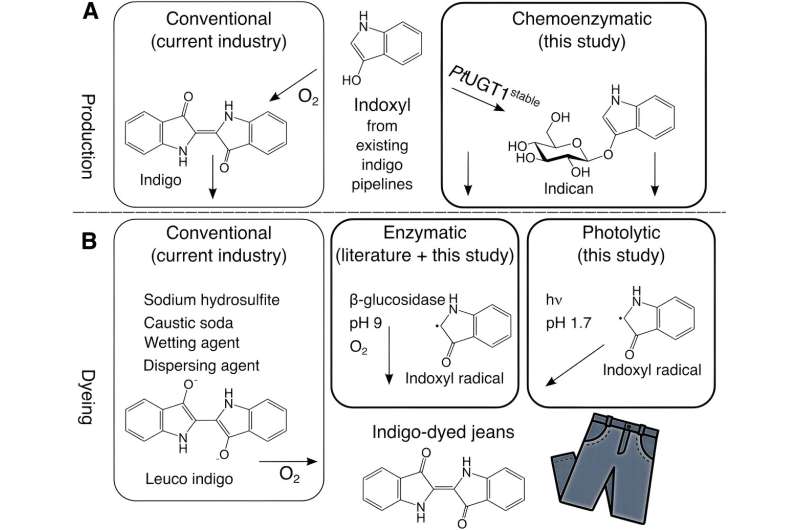This article has been reviewed according to Science X's editorial process and policies. Editors have highlighted the following attributes while ensuring the content's credibility:
fact-checked
peer-reviewed publication
reputable news agency
proofread
New dyeing method could help jeans shrink toxic problem

Can the multi-billion-dollar denim industry keep producing blue jeans in every shape, size and silhouette, while shrinking oversized levels of hazardous pollution? Research published Tuesday suggests a new dye could be a step in the right direction.
Scientists have been searching for ways to make a more sustainable form of indigo, used for centuries to color textiles, but which in its modern synthetic form needs toxic chemicals, large quantities of water and is linked to substantial carbon dioxide emissions.
But a study published in the journal Nature Communications suggests ditching the classic dye altogether.
Using Indican—a colorless compound also derived form indigo-producing plants—could reduce the environmental and societal impacts associated with dying jeans by around 90 percent because it does not need toxic chemicals, researchers said.
"It's been known for some years that indigo could be replaced by this other chemical called indican, because you can use it without any strong chemicals," study author Ditte Hededam Welner, a researcher at the Novo Nordisk Foundation Center for Biosustainability Enzyme Engineering and Structural Biology, told AFP.
The researchers engineered a variant of an enzyme found in the indigo-producing plant that could produce indican on an industrial scale.
While they said production of indican would still require polluting petrochemicals, so would not be significantly better than producing synthetic indigo, the benefits come when the dye is put to use.
Indican in powdered form can be dissolved in water then used on fabric and activated with either an enzyme or exposure to light.
The study found light-driven dyeing could cut the environmental damage of traditional indigo dyeing by 73 percent, while using the enzyme could slash the impacts by up to 92 percent.
In both cases, the classic blue jean color turns up the same as when conventional indigo is used.
Researchers suggest that, if indican were to replace indigo to dye the nearly four billion jeans traded annually, there would be a significant reduction in production of toxic waste and global CO2 emissions.
The authors, who have a published patent for their study, acknowledged limitations to their work, including a lack of facilities to simulate indican production at scale.
Indican could also be slightly more expensive than traditional dye, they said.
But the study said growing consumer demand for sustainable clothing could still make indican "a commercially viable route".
More information: Katrine Qvortrup, Chemoenzymatic indican for light-driven denim dyeing, Nature Communications (2024). DOI: 10.1038/s41467-024-45749-3. www.nature.com/articles/s41467-024-45749-3
Journal information: Nature Communications
© 2024 AFP




















